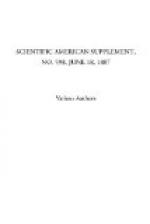The present century cannot boast of any great characteristic style in either architecture or ornament. Whether it is only in a course of development, and what will be the results, time only can show. All styles are now in vogue, hence the importance of accurate knowledge on the subject. To be able to judge of and appreciate the best, and to profit by the labors of those gone before us, at the same time imparting individuality and character to our own design, should be the aim and object of the study of decoration, and it should enter into any scheme of general education and culture.—Journal of Education.
* * * * *
THE MONTAUD ACCUMULATOR.
This accumulator is of the Plante type, and is modified so as to obtain a more rapid formation, a larger surface, and a symmetrical distance of the plates from each other. If into an alkaline bath saturated with litharge (added in excess) we plunge two lead electrodes and pass in a current of suitable tension and intensity, there is deposited upon the anode a layer of peroxide of lead varying in thickness with the intensity of the current, and more or less rich in oxygen according to the intensity of the bath, while the cathode is covered with a stratum of reduced lead. The liquid of the bath supplies material for both deposits, while in galvanoplastic operations the anode supplies it to the cathode. The principle of the formation consists in introducing in an efficacious manner currents of a great intensity, and thus abridging its duration.
Of two plates thus treated, the one becomes positive, and is covered with a thick layer of peroxide of lead. On leaving the bath it undergoes various preparations and several washings, and is then fit to be mounted along with others to form an accumulator ready to be charged and to work. The second, or negative, plate is covered with a thick sponge of lead. It is carefully washed, preserved in water with exclusion of air, and submitted to a very considerable pressure. After this operation it presents the appearance of ordinary sheet lead, but though the physical porosity has disappeared, the chemical porosity is intact, and this alone comes into play in accumulators. When a negative plate is constructed in this manner, it is ready to be combined with the positives to form an accumulator.
The inventor has sometimes put into the bath at the positive pole negative plates prepared as just described. They become very easily peroxidized, but they have the grave defect of requiring two preparations in place of one. To secure an accumulator against any leakage from plate, the solderings and the entire plates must be submerged in the liquid, so that nothing projects up out of the acidulated water except two strong rods for making contact. These rods are covered with an insulating varnish from their origin to above the point where they issue from the liquid.




